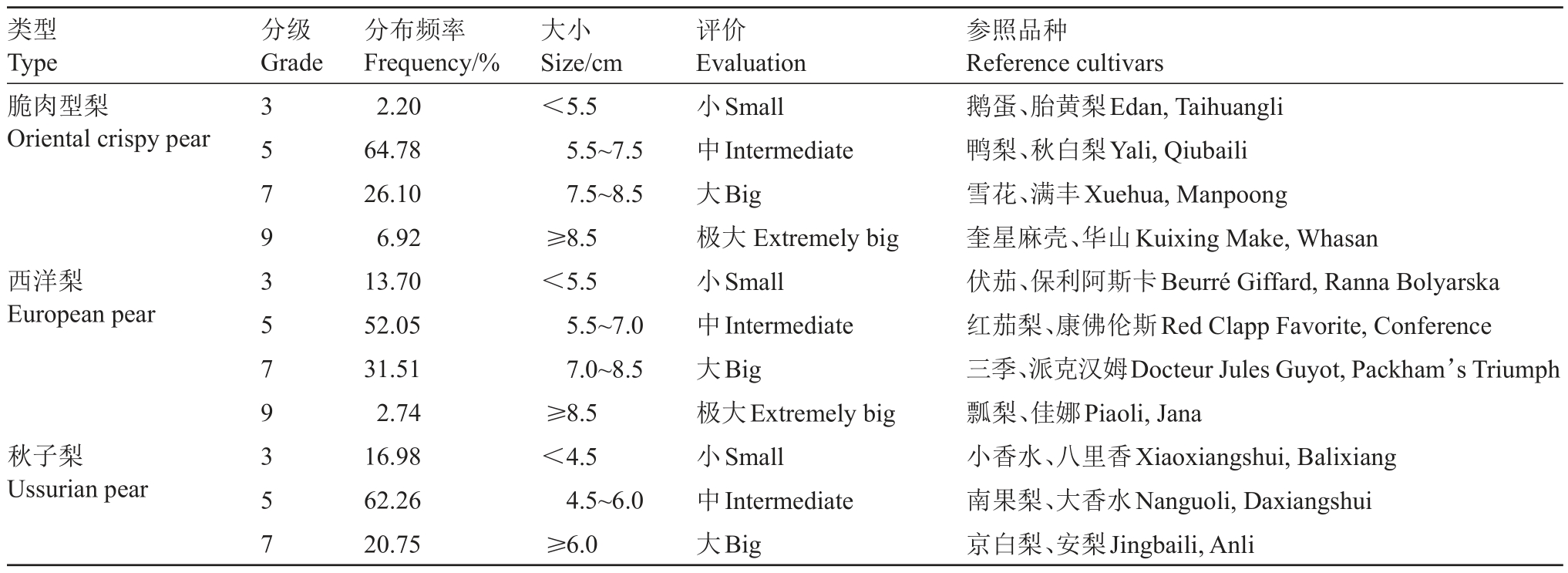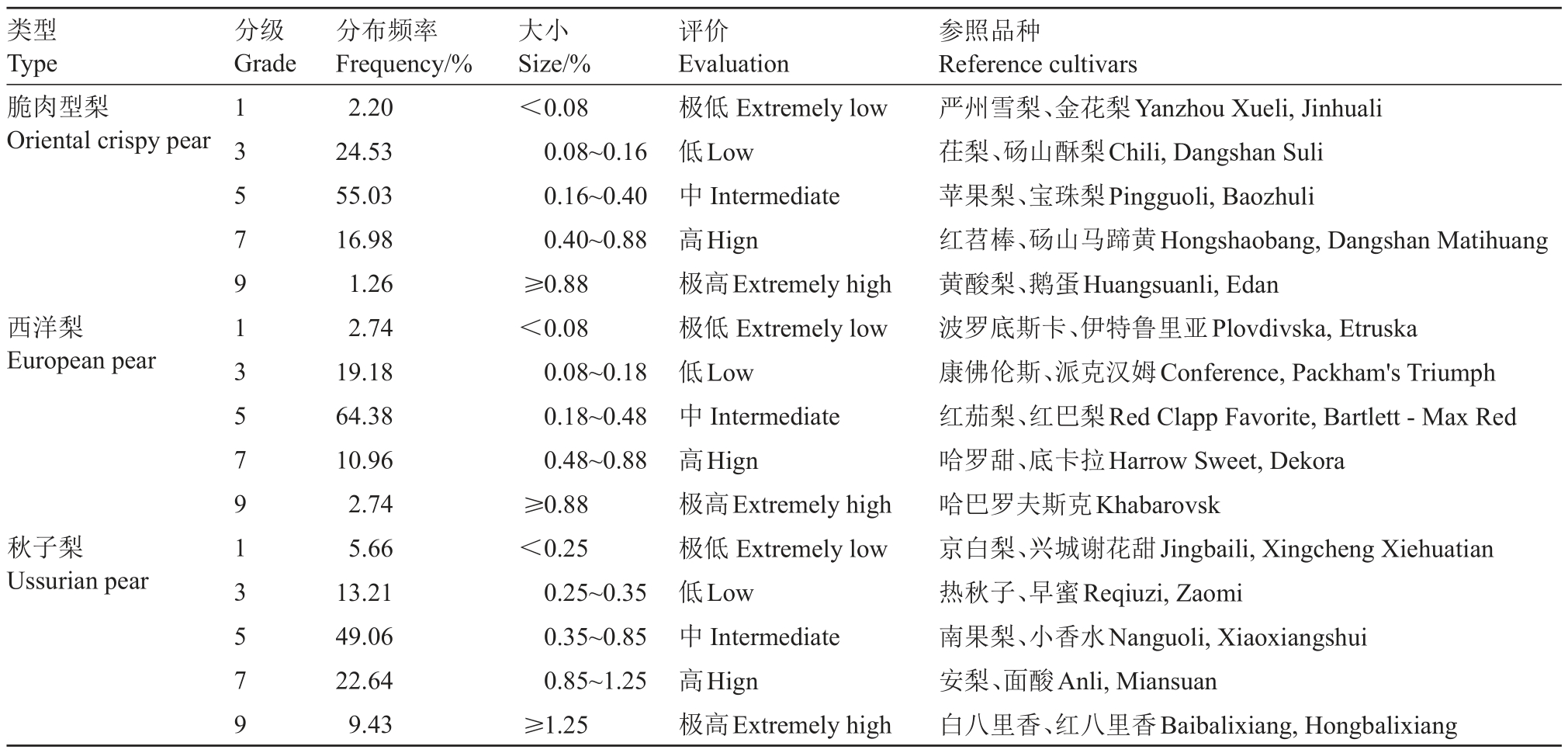种质资源评价工作是资源合理利用的重要前提。在国际上,国际植物遗传资源研究所(International Plant Genetic Resources Institute, IPGRI)1983年出版了梨的描述符标准[1],国际植物新品种保护联盟(The International Union for the Protection of New Varieties of Plants, UPOV)于2000 年出版了西洋梨新品种特异、一致性和稳定性测试标准[2]。中国于1990年和2006年分别出版了《果树种质资源描述符》[3]和《梨种质资源描述规范和数据标准》[4],对梨种质资源性状的描述和数据标准做了详细的解释,为梨种质资源数量性状的分级评价奠定了基础。这些标准的出台为建立梨种质资源的“国际语言”和促进梨种质资源评价工作开展起到了积极作用。然而,IPGRI 国际标准对梨各数量性状均无数值指标,仅列出了对照品种[1],UPOV 标准仅适用于西洋梨[2];中国标准除个别性状具有数量指标或参照品种外,绝大部分性状既没有数值指标,也没有参照品种,只有调查项目[3-4]。
目前,我国学者已对桃、杧果、枣、西瓜和南瓜等多种园艺作物数量性状进行了分级评价研究[5-12]。以梨种质资源数量性状的标准化描述和数据采集为基础,结合分子标记技术开展了数量性状定位、资源遗传多样性分析及资源分类学等方面的研究也很多[13-19]。中国作为梨的原产国,种质资源极为丰富,表型性状的系统描述对其起源、演化及品种资源的分类和多样性研究均具有重要参考价值,是种质资源共享体系建立的基础。在所有梨种质资源表型性状中,果实性状是决定梨品质和鉴定梨种类的最有价值的表型特征,对梨种质资源的正确分类具有重要意义。为了进一步完善我国梨种质资源描述评价体系,确定梨若干果实数量性状的分级评价指标及参照品种,笔者在本研究中通过对国家果树种质兴城梨圃内保存的570份资源的若干果实数量性状数据进行统计分析,在参照国际和国内标准的同时,结合我国梨种质资源评价工作的实际,对单果质量、果实横径、果实纵径、果心大小、果梗长度、果梗粗度、果肉硬度、可溶性固形物含量和可滴定酸含量等9个果实数量性状的分级评价指标和参照品种进行了探讨,为梨种质资源描述的规范化和标准化提供理论依据。
1 材料和方法
1.1 材料
试验于2016—2020 年在国家果树种质兴城梨圃内进行,数据采集自11~50 年生健壮树,共计11个种570 份材料,包括白梨(Pyrus bretschneideri)119 份、砂梨(P.pyrifolia)126 份(其中日韩砂梨36份)、秋子梨(P.ussuriensis)98 份(含野生种质45份)、新疆梨(P.sinkiangensis)23 份、西洋梨(P.communis)70 份、杜梨(P.betuleafolia)4 份、豆梨(P.calleryana)4 份、川梨(P.pashia)3 份、河北梨(P.hopei-ensis)1 份、褐梨(P.phaeocarpa)3 份、木梨(P.xerophila)5 份和新品种(P.hybrid)114 份(含脆肉型梨73份)。
1.2 方法
1.2.1 数据采集 采集数据包括单果质量、果实横径、果实纵径、果肉硬度、可溶性固形物含量、可滴定酸含量、果梗长度、果梗粗度和果心大小,具体方法参照《梨种质资源描述规范和数据标准》[4],其中果肉硬度和可滴定酸含量分别用GY-4 型果实硬度计和905 Titrando 全自动电位滴定仪测定。数据资料为3 a(年)平均值。
1.2.2 统计分析 使用Microsoft Excel 2007 和SPSS19.0软件对数据进行统计分析,统计果实性状数据的最小值、最大值、平均值、中位数、偏态度、变异系数,并绘制各数量性状数据的频率分布直方图(含正态曲线),并参照王力荣等[5]用等距法对各数量性状分级、评价描述和选取参照品种。
2 结果与分析
2.1 梨种质资源果实性状变异系数及分布状态
变异系数的大小反映品种固有特征及品种间的个体差异,是性状遗传多样性的具体体现,性状变异系数越大,遗传背景越丰富,越有利于品种鉴定[5]。9个性状的变异情况见表1,其中可滴定酸含量的变异系数最大,为128.43%,因此可滴定酸含量更能反映品种间的差异;可溶性固形物含量的变异系数较小,为13.67%,说明可溶性固形物含量的遗传特性较其他8个性状稳定。平均值和中位数的差异反映了性状数据的集散性,其中果梗粗度和果肉硬度平均值和中位数的差异<0.1,其余都≥0.1,说明相对于其他7 个性状果梗粗度和果肉硬度这2 个性状的数据相对比较集中。偏态度的大小反映出偏正态分布数据峰值相对于正态分布数据峰值左右偏移的程度,结果表明各数量性状均为偏正态分布,其中果实横径、果实纵径和果梗长度的偏态度为负值,其余为正值,可滴定酸含量的偏态度最大(2.75),果梗长度的偏态度最小(-0.13)。
表1 梨种质资源果实数量性状变异情况
Table 1 Variations of fruit quantitative traits of pear resources

性状Traits单果质量Mass of single fruit/g果实横径Fruit diameter/cm果实纵径Fruit length/cm果肉硬度Flesh firmness/(kg·cm-2)w(可溶性固形物)Soluble solids content/%w(可滴定酸)Titratable acidity/%果心大小Fruit core size/%果梗长度Stalk length/cm果梗粗度Stalk thickness/mm资源数No.of resources 570 570 570 570 570最小值Min 0.80 1.02 1.05 0.79 9.27最大值Max 495.00 9.54 12.63 7.40 22.81平均值Mean 164.35 6.38 6.45 3.23 13.09中位数Median 165.09 6.65 6.59 3.20 12.74偏态度Skewness 0.30-0.97-0.20 0.40 1.43变异系数Coefficient of variation/%52.98 22.42 28.50 35.30 13.67 570 570 570 570 0.04 20.92 1.01 0.68 4.20 71.59 7.00 4.93 0.55 41.40 3.85 2.60 0.30 39.92 3.96 2.55 2.75 0.83-0.13 0.47 128.43 20.54 28.80 20.05
2.2 梨种质资源果实性状分级指标及参照品种
对果梗长度、果梗粗度和果心大小(果心横径和果实横径的比)进行统计分析(表1),结果均为偏正态分布。果梗长度变异系数(28.80%)>果心大小(20.54%)>果梗粗度(20.05%)。果梗粗度对果实膨大有一定影响,果梗粗,利于营养的运输果实更易膨大。果心大小是影响可食率的重要性状之一,果心越小可食率越高。绘制果梗长度、粗度和果心大小频率分布直方图(图1)。按果梗长度和果梗粗度可将梨种质资源分为5级评价(表2),按果心大小可将梨种质资源分为4级评价(表3)。

图1 果梗长度、果梗粗度和果心大小频率分布
Fig.1 Frequency distribution of stalk length,stalk thickness and fruit core size
表2 果梗长度和果梗粗度分级指标及参照品种
Table 2 Scale index and reference cultivars of stalk length and stalk thickness

注:组距下限归类于下一组。下同。
Note:The lower value for every group belongs to the next group.The same below.
性状Traits果梗长度Stalk length/cm分级Scale果梗粗度Stalk thickness/mm 1 3 5 7 9 1 3 5 7 9分布频率Frequency/%1.42 18.15 50.53 27.76 2.14 3.20 24.20 41.46 19.40 11.74大小Size<1.5 cm 1.5~3.0 cm 3.0~4.5 cm 4.5~6.0 cm≥6.0 cm<2.0 mm 2.0~2.4 mm 2.4~2.8 mm 2.8~3.2 mm≥3.2 mm评价Evaluation极短Extremely short短Short中Intermediate长Long极长Extremely long极细Extremely fine细Fine中Intermediate粗Coarse极粗Extremely coarse参照品种Reference cultivars满园香、粉酪Manyuanxiang,Butirra Rosata Morettini南果梨、波罗底斯卡Nanguoli,Plovdivska湘南、玉露香Shounan,Yuluxiang巍山红雪梨、鸭梨Weishan Hongxueli,Yali黄县长把、雪花Huangxian Changba,Xuehua京白梨、长把酥Jingbaili,Changbasu八里香、花长把Balixiang,Huachangba巍山红雪梨、安梨Weishan Hongxueli,Anli雁荡雪、派克汉姆Yandang Xueli,Packham’s Triumph三季、红火把Docteur Jules Guyot,Honghuoba
表3 果心大小分级指标及参照品种
Table 3 Scale index and reference cultivars of fruit core size

分级Grade 1 3 5 7分布频率Frequency/%0.53 14.06 72.24 13.17大小Size<1/4 1/4~1/3 1/3~1/2 1/2评价Evaluation极小Extremely small小Small中Intermediate大Big参照品种Reference cultivars蒲瓜梨、德尚斯梨Puguali,Vereins Dechanstbirne锦丰、砀山酥梨Jinfeng,Dangshan Suli金川雪梨、南果梨Jinchuan Xueli,Nanguoli八里香、红八里香Balixiang,Hongbalixiang
2.3 梨栽培品种果实性状变异系数及分布状态
梨栽培品种从果实类型上分为脆肉型梨和软肉型梨两种,脆肉型梨包括白梨、砂梨和脆肉型梨新品种,软肉型梨又分为秋子梨和西洋梨两种。脆肉型梨、秋子梨和西洋梨三者的果实从外观和内质区别都比较明显,在果实性状分级指标上需要区别对待。
对318份脆肉型梨、70份西洋梨和53份秋子梨的单果质量、果实横径、果实纵径、果肉硬度、可溶性固形物含量和可滴定酸含量等果实性状进行统计分析和分级评价(表4),平均数和中位数的差值可以看出数据的分散程度,单果质量相对于果实横径、果实纵径、果肉硬度、可溶性固形物含量和可滴定酸含量数据较分散。偏态度的大小反映出偏正态分布数据,峰值相对于正态分布数据峰值左右偏移的程度,西洋梨果实纵径的偏态度小于0.1,为正态分布,其余性状偏态度绝对值大于0.1,为偏正态分布。西洋梨单果质量变异系数(40.54% )>秋子梨(40.42%)>脆肉型梨(33.38%),西洋梨果实横径变异系数(14.50%)>秋子梨(14.05%)>脆肉型梨(11.80%),西洋梨果实纵径变异系数(20.85%)>脆肉型梨(15.34%)>秋子梨(15.15%),秋子梨果肉硬度变异系数(26.46%)>西洋梨(25.89%)>脆肉型梨(22.16%),秋子梨可溶性固形物含量变异系数(10.51%)>西洋梨(9.69%)>脆肉型梨(9.14%),脆肉型梨可滴定酸含量变异系数(66.00%)>西洋梨(62.86%)>秋子梨(49.31%)
表4 梨栽培品种果实性状变异情况
Table 4 Variations of fruit quantitative traits of pear cultivars

注:OCP.脆肉型;UP.秋子梨;EP.西洋梨。
Note:OCP.Oriental crispy pear;UP.Ussurian pear;EP.European pear.
性状Traits脆肉型梨单果质量Mass of single fruit of OCP/g西洋梨单果质量Mass of single fruit of EP/g秋子梨单果质量Mass of single fruit of UP/g脆肉型梨果实横径Fruit diameter of OCP/cm西洋梨果实横径Fruit diameter of EP/cm秋子梨果实横径Fruit diameter of UP/cm脆肉型梨果实纵径Fruit length of OCP/cm西洋梨果实纵径Fruit length of EP/cm秋子梨果实纵径Fruit length of UP/cm脆肉型梨果肉硬度Flesh firmness of OCP/(kg·cm-2)西洋梨果肉硬度Flesh firmness of EP/(kg·cm-2)秋子梨果肉硬度Flesh firmness of UP/(kg·cm-2)w(脆肉型梨可溶性固形物)Soluble solids content of OCP/%w(西洋梨可溶性固形物)Soluble solids content of EP/%w(秋子梨可溶性固形物)Soluble solids content of UP/%w(脆肉型梨可滴定酸)Titratable acidity of OCP/%w(西洋梨可滴定酸)Titratable acidity of EP/%w(秋子梨可滴定酸)Titratable acidity of UP/%脆肉型梨平均Mean of OCP西洋梨平均Mean of EP秋子梨平均Mean of UP资源数No.of resources 318 70 53 318 70 53 318 70 53 318 70 53 318 70 53 318 70 53最小值Min 33.03 52.75 32.95 3.79 4.35 3.83 3.80 4.85 3.35 3.65 1.37 2.33 9.27 10.20 11.83 0.04 0.06 0.16最大值Max 495.00 356.60 166.95 9.54 8.70 6.64 10.47 12.63 6.27 12.80 5.74 8.79 17.12 16.44 18.73 1.16 1.09 1.43平均值Mean 210.19 169.50 79.43 7.15 6.52 5.21 7.04 8.13 4.67 6.92 3.44 4.70 12.28 13.51 14.24 0.28 0.30 0.70中位数Median 204.60 175.65 72.55 7.15 6.62 5.18 6.96 8.14 4.63 6.64 3.42 4.54 12.24 13.62 14.05 0.23 0.26 0.64变异系数Coefficient of variation/%33.38 40.54 40.42 11.80 14.50 14.05 15.34 20.85 15.15 22.16 25.89 26.46 9.14 9.69 10.51 66.00 62.86 49.31 26.30 29.06 25.98偏态度Skewness 0.68 0.30 0.76-0.17-0.34 0.14 0.48 0.07 0.27 0.90 0.24 0.98 0.68-0.28 0.89 1.78 2.01 0.36
2.4 梨栽培品种果实性状分级指标及参照品种
2.4.1 果实大小 果实大小可用单果质量、果实横径和果实纵径来衡量。绘制脆肉型梨、西洋梨和秋子梨果实大小频率分布直方图(图2)。其中,脆肉型梨果实横径和果实纵径的分布图,在7.0~7.5 cm 横径频率高于纵径,原因是这个等级扁圆形的果占一定比例。秋子梨以扁圆形果实为主,但4.0~5.0 cm纵径频率高于横径,说明这个等级中包含非扁圆形果实。按单果质量、果实横径和果实纵径可将脆肉型梨和西洋梨分为4 级评价,秋子梨分为3 级评价(表5~表7)。

图2 果实大小频率分布
Fig.2 Frequency distribution of fruit size
表5 单果质量分级指标及参照品种
Table 5 Scale index and reference cultivars of weight per fruit

类型Type脆肉型梨Oriental crispy pear分级Grade西洋梨European pear秋子梨Ussurian pear 3 5 7 9 3 5 7 9 3 5 7分布频率Frequency/%1.89 44.03 43.40 10.69 16.44 50.68 30.14 2.74 18.52 68.52 12.96大小Size/g<100.0 100.0~200.0 200.0~300.0≥300.0<100.0 100.0~200.0 200.0~300.0≥300.0<50.0 50.0~120.0≥120.0评价Evaluation小Small中Intermediate大Big极大Extremely big小Small中Intermediate大Big极大Extremely big小Small中Intermediate大Big参照品种Reference cultivar鹅蛋、胎黄梨Edan,Taihuangli鸭梨、秋白梨Yali,Qiubaili雪花、砀山酥梨Xuehua,Dangshan Suli满丰、苍溪雪梨Manpoong,Cangxi Xueli伏茄、保利阿斯卡Beurré Giffard,Ranna Bolyarska红茄梨、康佛伦斯Red Clapp Favorite,Conference派克汉姆、三季Packham’s Triumph,Docteur Jules Guyot瓢梨、佳娜Piaoli,Jana小香水、八里香Xiaoxiangshui,Balixiang南果梨、大香水Nanguoli,Daxiangshui京白梨、安梨Jingbaili,Anli
表6 果实横径分级指标及参照品种
Table 6 Scale index and reference cultivars of fruit diameter

类型Type脆肉型梨Oriental crispy pear分级Grade西洋梨European pear秋子梨Ussurian pear 3 5 7 9 3 5 7 9 3 5 7分布频率Frequency/%2.20 64.78 26.10 6.92 13.70 52.05 31.51 2.74 16.98 62.26 20.75大小Size/cm<5.5 5.5~7.5 7.5~8.5≥8.5<5.5 5.5~7.0 7.0~8.5≥8.5<4.5 4.5~6.0≥6.0评价Evaluation小Small中Intermediate大Big极大Extremely big小Small中Intermediate大Big极大Extremely big小Small中Intermediate大Big参照品种Reference cultivars鹅蛋、胎黄梨Edan,Taihuangli鸭梨、秋白梨Yali,Qiubaili雪花、满丰Xuehua,Manpoong奎星麻壳、华山Kuixing Make,Whasan伏茄、保利阿斯卡Beurré Giffard,Ranna Bolyarska红茄梨、康佛伦斯Red Clapp Favorite,Conference三季、派克汉姆Docteur Jules Guyot,Packham’s Triumph瓢梨、佳娜Piaoli,Jana小香水、八里香Xiaoxiangshui,Balixiang南果梨、大香水Nanguoli,Daxiangshui京白梨、安梨Jingbaili,Anli
表7 果实纵径分级指标及参照品种
Table 7 Scale index and reference cultivars of fruit length

类型Type脆肉型梨Oriental crispy pear分级Grade西洋梨European pear秋子梨Ussurian pear 3 5 7 9 3 5 7 9 3 5 7分布频率Frequency/%4.72 44.97 40.88 9.43 15.07 57.53 20.55 6.85 18.52 68.52 12.96大小Size/cm<5.5 5.5~7.0 7.0~8.5≥8.5<6.0 6.0~9.0 9.0~11.0≥11.0<4.0 4.0~5.5≥5.5评价Evaluation小Small中Intermediate大Big极大Extremely big小Small中Intermediate大Big极大Extremely big小Small中Intermediate大Big参照品种Reference cultivars鹅蛋、新水Edan,Shinsui秋白梨、水红宵Qiubaili,Shuihongxiao砀山酥梨、鸭梨Dangshan Suli,Yali金花梨、苍溪雪梨Jinhuali,Cangxi Xueli海寿兹卡、波Harozka,Bo红茄梨、康佛伦斯Red Clapp Favorite,Conference三季、红巴梨Docteur Jules Guyot,Bartlett-Max Red瓢梨、阿巴特Piaoli,Abbe Fetel小香水、八里香Xiaoxiangshui,Balixiang南果梨、大香水Nanguoli,Daxiangshui尖把梨、鸭广梨Jianbali,Yaguangli
2.4.2 果肉硬度 果肉硬度是指果实在最佳食用期的去皮硬度。绘制脆肉型梨、西洋梨和秋子梨果肉硬度频率分布直方图(图3)。脆肉型梨果肉硬度小于5 kg·cm-2的资源果肉类型一般为疏松,5~9 kg·cm-2的资源果肉类型一般为疏松、松脆、脆或紧脆,大于9 kg·cm-2的资源果肉类型一般为脆、紧脆或紧密。西洋梨果肉硬度分布在1.37~5.74 kg·cm-2,果肉类型包括软溶、软、软面和沙面。秋子梨果肉硬度小于3 kg·cm-2的资源果肉类型一般为软溶,5~6 kg·cm-2的资源果肉类型一般为软、软面或松软,大于6 kg·cm-2的资源果肉类型一般为松脆。按果肉硬度可将脆肉型梨、西洋梨和秋子梨分为3级评价(表8)。

图3 果肉硬度频率分布
Fig.3 Frequency distribution of flesh firmness
表8 果肉硬度分级指标及参照品种
Table 8 Scale index and reference cultivars of flesh firmness

类型Type脆肉型梨Oriental crispy pear分级Grade西洋梨European pear秋子梨Ussurian pear 3 5 7 3 5 7 3 5 7分布频率Frequency/%12.26 76.42 11.32 4.11 71.23 24.66 7.55 81.13 11.32大小Size/(kg·cm-2)<5.0 5.0~9.0≥9.0<2.0 2.0~4.0≥4.0<3.0 3.0~6.0≥6.0评价Evaluation低Low中Intermediate高Hign低Low中Intermediate高Hign低Low中Intermediate高Hign参照品种Reference cultivars砀山酥梨、玉露香Dangshan Suli,Yuluxiang雪花、水红宵Xuehua,Shuihongxiao绥中马蹄黄、子母梨Suizhong Matihuang,Zimuli美尼梨、斯查拉Menie,Dobra Szara红茄梨、三季Red Clapp Favorite,Docteur Jules Guyot斯伯丁、哈罗甜Spalding,Harrow Sweet南果梨、小香水Nanguoli,Xiaoxiangshui面酸、京白梨Miansuan,Jingbaili秋子、甜秋子Qiuzi,Tianqiuzi
2.4.3 可溶性固形物含量 绘制脆肉型梨、西洋梨和秋子梨可溶性固形物含量频率分布直方图(图4)。按可溶性固形物含量可将脆肉型梨、西洋梨和秋子梨分为5级评价(表9)。

图4 可溶性固形物含量频率分布
Fig.4 Frequency distribution of soluble solids content
表9 可溶性固形物含量分级指标及参照品种
Table 9 Scale index and reference cultivars of soluble solids content

类型Type脆肉型梨Oriental crispy pear分级Grade西洋梨European pear秋子梨Ussurian pear 1 3 5 7 9 1 3 5 7 9 1 3 5 7 9分布频率Frequency/%4.40 18.55 55.66 15.09 6.29 4.11 16.44 40.03 33.94 5.48 3.77 18.87 52.83 13.21 11.32大小Size/%<10.5 10.5~11.5 11.5~13.0 13.0~14.0≥14.0<11.0 11.0~12.5 12.5~14.0 14.0~15.5≥15.5<12.0 12.0~13.0 13.0~15.0 15.0~16.0≥16.0评价Evaluation极低Extremely low低Low中Intermediate高Hign极高Extremely high极低Extremely low低Low中Intermediate高Hign极高Extremely high极低Extremely low低Low中Intermediate高Hign极高Extremely high参照品种Reference cultivars奎星麻壳、湘南Kuixing Make,Shounan严州雪梨、苍溪雪梨Yanzhou Xueli,Cangxi Xueli砀山酥梨、雪花Dangshan Suli,Xuehua丰水、宝珠梨Housui,Baozhuli锦丰、晋酥梨Jinfeng,Jinsuli保利阿斯卡、夏血梨Ranna Bolyarska,Summer Blood Birne达马列斯、朱丽比恩Damaliesi,Bunte Julibirne三季、红茄梨Docteur Jules Guyot,Red Clapp Favorite伏茄、康佛伦斯Beurré Giffard,Conference好本号、马道美Allexandrine Douillard,Madame Verte小五香、辉山白Xiaowuxiang,Huishanbai秋子、甜秋子Qiuzi,Tianqiuzi京白梨、大香水Jingbaili,Daxiangshui花盖、安梨Huagai,Anli南果梨、八里香Nanguoli,Balixiang
2.4.4 可滴定酸含量 绘制脆肉型梨、西洋梨和秋子梨可滴定含量频率分布直方图(图5)。脆肉型梨可滴定酸含量小于0.08%的梨资源果实风味一般为淡甜,0.08%~0.16%的资源果实风味一般为淡甜或甜,0.16%~0.40%的资源果实风味一般为甜和酸甜,0.40%~0.88%的资源果实风味一般为甜酸,≥0.88%的资源果肉风味一般为酸。西洋梨可滴定酸含量小于0.18%的资源果实风味一般为甘甜、甜或酸甜,0.18%~0.48%的资源果肉风味一般为甜、酸甜或甜酸,0.48%~0.88%的资源果肉风味一般为酸甜或甜酸,≥0.88%的资源果肉风味一般为酸。秋子梨可滴定酸含量<0.25%的资源果实风味一般为甜或酸甜,0.25%~0.35%的资源果实风味一般为酸甜或甜酸,0.35%~0.85%的资源果肉风味一般为酸甜、甜酸或酸,≥0.85%的资源果肉风味一般为甜酸或酸。按可滴定酸含量可将脆肉型梨、西洋梨和秋子梨分为5级评价(表10)。

图5 可滴定酸含量频率分布
Fig.5 Frequency distribution of titratable acidity
表10 可滴定酸含量分级指标及参照品种
Table 10 Scale index and reference cultivars of titratable acidity

类型Type脆肉型梨Oriental crispy pear分级Grade西洋梨European pear秋子梨Ussurian pear 1 3 5 7 9 1 3 5 7 9 1 3 5 7 9分布频率Frequency/%2.20 24.53 55.03 16.98 1.26 2.74 19.18 64.38 10.96 2.74 5.66 13.21 49.06 22.64 9.43大小Size/%<0.08 0.08~0.16 0.16~0.40 0.40~0.88≥0.88<0.08 0.08~0.18 0.18~0.48 0.48~0.88≥0.88<0.25 0.25~0.35 0.35~0.85 0.85~1.25≥1.25评价Evaluation极低Extremely low低Low中Intermediate高Hign极高Extremely high极低Extremely low低Low中Intermediate高Hign极高Extremely high极低Extremely low低Low中Intermediate高Hign极高Extremely high参照品种Reference cultivars严州雪梨、金花梨Yanzhou Xueli,Jinhuali茌梨、砀山酥梨Chili,Dangshan Suli苹果梨、宝珠梨Pingguoli,Baozhuli红苕棒、砀山马蹄黄Hongshaobang,Dangshan Matihuang黄酸梨、鹅蛋Huangsuanli,Edan波罗底斯卡、伊特鲁里亚Plovdivska,Etruska康佛伦斯、派克汉姆Conference,Packham's Triumph红茄梨、红巴梨Red Clapp Favorite,Bartlett-Max Red哈罗甜、底卡拉Harrow Sweet,Dekora哈巴罗夫斯克Khabarovsk京白梨、兴城谢花甜Jingbaili,Xingcheng Xiehuatian热秋子、早蜜Reqiuzi,Zaomi南果梨、小香水Nanguoli,Xiaoxiangshui安梨、面酸Anli,Miansuan白八里香、红八里香Baibalixiang,Hongbalixiang
3 讨 论
数量性状虽然受环境条件和栽培条件影响较大,但当群体足够大时,仍然能够代表某一群体的变异情况和遗传多样性[5]。种质资源遗传多样性在同一个体或不同个体间也有不同程度的差异,其差异性对品种的改良和选育有着直接的影响,种质资源数量性状变异系数越大,遗传多样性程度越高[6-12]。对570份梨种质的9个果实性状分析发现,可滴定酸含量的变异系数最大为128.43%,可溶性固形物含量的变异系数较小为13.67%,说明种质表型差异明显,具有丰富的遗传多样性。本研究结果与以往研究结果相比较,梨种质资源果实性状的平均变异系数41.95%[15]>叶片和枝条的平均变异系数19.09%[14]>花器官的平均变异系数14.21%[13],这是由于果实性状往往是人为定向选择的目标,例如高酸品种为优良的加工品种,选育果心小的品种对提高可食率有重要意义。
梨种质资源9个果实数量性状均不符合标准正态分布,据有关学者研究,枣[20]、李[21]和榛子[22]等果树的部分数量性状也不符合正态分布,其原因可能是长期人为选择的结果。此外,果形中包含扁圆形、圆形、葫芦形等质量性状的等位基因,不是单纯的数量性状。但如果将这些植物学性状分别进行等级划分,则必然造成标准划分过细,影响标准的实用性[5]。
国内外对农作物数量性状的分级方法归纳起来主要有9 级、5 级和3 级等分级方法,如王力荣等[6]对桃果实数量性状采用5 级分类法,刘孟军[9]对枣树数量性状分别用5 级和3 级分类法,周俊国等[10]等对蔓生南瓜数量性状采用了9 级分类法。梨资源果实数量性状数据均为连续分布,不同性状的变异幅度差异较大,本研究分级评价主要考虑到数量性状的分布状态、引种者对数量性状的常用评价以及方便国际间的交流,对梨种质资源果梗长度、果梗粗度和果心大小采用5级和4级分级方法;对梨栽培品种(脆肉型梨、秋子梨和西洋梨)单果质量、果实横径、果实纵径、果肉硬度、可溶性固形物含量和可滴定酸含量等6 个性状采取了5 级、4 级和3级3种不同的分级方法。梨栽培品种中西洋梨的平均变异系数29.06%>脆肉型梨26.30%>秋子梨25.98%。可溶性固形物含量秋子梨14.24%>西洋梨13.51%>脆肉型梨12.28%,可滴定酸含量秋子梨0.70%>西洋梨0.30%>脆肉型梨0.28%。
笔者在本研究中对梨果实数量性状进行了概率分级,提出了基于数量性状分布特征的梨果实性状的概率分级指标体系,较好地体现了梨果实性状变异的中值和离散程度及各级性状值占总变异的比例,为梨种质资源的评价描述、品种选育及生产中果实分级提供了参考。
4 结 论
梨种质资源9个果实数量性状中可滴定酸含量的变异系数最大,更能体现梨品种间的差异。9 个性状均不符合标准正态分布,其原因可能是长期人为选择的结果。软肉型梨(秋子梨和西洋梨)的平均可溶性固形物和可滴定酸含量大于脆肉型梨。9个果实数量性状采用了3 级、4 级和5 级等3 种不同的分级方法。
[1]IBPGR.Pear descriptors[M].Rome:International Board for Plant Genetic Resources,1983.
[2]UPOV.Guidelines for the conduct of tests for distinctness, uniformity and stability,Pear(Pyrus communis L.)[M].Geneva:International Union for the Protection of New Varieties of Plants,2000.
[3]蒲富慎.果树种质资源描述符:记载项目及评价标准[M].北京:农业出版社,1990:23-39.PU Fushen.Descriptors of fruit tree germplasm resources:Record items and evaluation criteria[M].Beijing:Agricultural Press,1990:23-39.
[4]曹玉芬.梨种质资源描述规范和数据标准[M].北京:中国农业出版社,2006.CAO Yufen.Descriptors and data standard for pear (Pyrus spp.)[M].Beijing:China Agriculture Press,2006.
[5]王力荣,朱更瑞,方伟超.桃种质资源若干植物学数量性状描述指标探讨[J].中国农业科学,2005,38(4):770-776.WANG Lirong,ZHU Gengrui,FANG Weichao.The evaluating criteria of some botanical quantitative characters of peach genetic resources[J].Scientia Agricultura Sinica,2005,38(4):770-776.
[6]王力荣,朱更瑞,方伟超.桃(Prunus persica L.)种质资源果实数量性状评价指标探讨[J].园艺学报,2005,32(1):1-5.WANG Lirong,ZHU Gengrui,FANG Weichao.The evaluating criteria of some fruit quantitative characters of peach (Prunus persica L.) genetic resources[J].Acta Horticulturae Sinica,2005,32(1):1-5.
[7]朱敏,高爱平,邓穗生,陈业渊.杧果种质资源果实主要数量性状评价指标探讨[J].植物遗传资源学报,2010,11(4):418-423.ZHU Min,GAO Aiping,DENG Suisheng,CHEN Yeyuan.Evaluation index of main quantitative characters of mango (Mangifera indica) genetic resources[J].Journal of Plant Genetic Resources,2010,11(4):418-423.
[8]马蔚红,谢江辉,武红霞,王松标.杧果种质资源果实数量性状评价指标探讨[J].果树学报,2006,23(2):218-222.MA Weihong,XIE Jianghui,WU Hongxia,WANG Songbiao.Evaluating criteria of some fruit quantitative characteristics of mango (Mangifera indica) germplasm resources[J].Journal of Fruit Science,2006,23(2):218-222.
[9]刘孟军.枣树数量性状的概率分级研究[J].园艺学报,1996,23(2):105-109.LIU Mengjun.Studies on the variations and probability gradings of major quantitative characters of Chinese jujube[J].Acta Horticulturae Sinica,1996,23(2):105-109.
[10]周俊国,李新峥,朱月林,李海真.蔓生型南瓜资源部分植物学数量性状的评价探讨[J].植物遗传资源学报,2007,8(1):30-34.ZHOU Junguo,LI Xinzheng,ZHU Yuelin,LI Haizhen.Evaluating criteria of some botanical quantitative characters of vining pumpkin (Cucurbita moschata Duch.) germplasm resources[J].Journal of Plant Genetic Resources,2007,8(1):30-34.
[11]尚建立,王吉明,郭琳琳,马双武.西瓜种质资源若干数量性状的评价指标探讨[J].果树学报,2011,28(3):479-484.SHANG Jianli,WANG Jiming,GUO Linlin,MA Shuangwu.Evaluating criteria of some quantitative characteristics of watermelon genetic resources[J].Journal of Fruit Science,2011,28(3):479-484.
[12]尚建立,王吉明,郭琳琳,马双武.甜瓜种质资源果实若干数量性状评价指标探讨[J].果树学报,2013,30(2):222-229.SHANG Jianli,WANG Jiming,GUO Linlin,MA Shuangwu.Evaluating criteria of some botanical quantitative characters of fruits in melon genetic resources[J].Journal of Fruit Science,2013,30(2):222-229.
[13]张莹,曹玉芬,霍宏亮,田路明,董星光,齐丹,张小双.基于花表型性状的梨种质资源多样性研究[J].园艺学报,2016,43(7):1245-1256.ZHANG Ying,CAO Yufen,HUO Hongliang,TIAN Luming,DONG Xingguang,QI Dan,ZHANG Xiaoshuang.Research on diversity of pear germplasm resources based on flowers phenotype traits[J].Acta Horticulturae Sinica,2016,43(7):1245-1256.
[14]张莹,曹玉芬,霍宏亮,徐家玉,田路明,董星光,齐丹,张小双,刘超,王立东.基于枝条和叶片表型性状的梨种质资源多样性[J].中国农业科学,2018,51(17):3353-3369.ZHANG Ying,CAO Yufen,HUO Hongliang,XU Jiayu,TIAN Luming,DONG Xingguang,QI Dan,ZHANG Xiaoshuang,LIU Chao,WANG Lidong.Diversity of pear germplasm resources based on twig and leaf phenotypic traits[J].Scientia Agricultura Sinica,2018,51(17):3353-3369.
[15]ZHANG Y,CAO Y F,HUO H L,XU J Y,TIAN L M,DONG X G,QI D,LIU C.An assessment of the genetic diversity of pear (Pyrus L.) germplasm resources based on the fruit phenotypic traits[J].Journal of Integrative Agriculture,2022,21(8):2275-2290.
[16]CAO Y F,TIAN L M,GAO Y,LIU F Z.Genetic diversity of cultivated and wild Ussurian Pear(Pyrus ussuriensis Maxim.)in China evaluated with M13-tailed SSR markers[J].Genetic Resources and Crop Evolution,2012,59(1):9-17.
[17]ZHANG R P,WU J,LI X G,KHAN M A,CHEN H,KORBAN S S,ZHANG S L.An AFLP,SRAP,and SSR genetic linkage map and identification of QTLs for fruit traits in pear(Pyrus L.)[J].Plant Molecular Biology Reporter,2013,31(3):678-687.
[18]WU J,LI L T,LI M,KHAN M A,LI X G,CHEN H,YIN H,ZHANG S L.High-density genetic linkage map construction and identification of fruit-related QTLs in pear using SNP and SSR markers[J].Journal of Experimental Botany,2014,65(20):5771-5781.
[19]张瑞萍,吴俊,李秀根,杨健,王龙,王苏珂,张绍铃.梨AFLP标记遗传图谱构建及果实相关性状的QTL 定位[J].园艺学报,2011,38(10):1991-1998.ZHANG Ruiping,WU Jun,LI Xiugen,YANG Jian,WANG Long,WANG Suke,ZHANG Shaoling.Construction of AFLP genetic linkage map and analysis of QTLs related to fruit traits in pear[J].Acta Horticulturae Sinica,2011,38(10):1991-1998.
[20]刘平,刘孟军,周俊义,毕平.枣树数量性状的分布类型及其概率分级指标体系[J].林业科学,2003,39(6):77-82.LIU Ping,LIU Mengjun,ZHOU Junyi,BI Ping.Distribution and probability grading index system of quantitative character of Chinese jujube[J].Scientia Silvae Sinicae,2003,39(6):77-82.
[21]郁香荷,章秋平,刘威生,孙猛,刘宁,张玉萍,徐铭.中国李种质资源形态性状和农艺性状的遗传多样性分析[J].植物遗传资源学报,2011,12(3):402-407.YU Xianghe,ZHANG Qiuping,LIU Weisheng,SUN Meng,LIU Ning,ZHANG Yuping,XU Ming.Genetic diversity analysis of morphological and agronomic characters of Chinese plum(Prunus salicina Lindl.) germplasm[J].Journal of Plant Genetic Resources,2011,12(3):402-407.
[22]李京璟,梁丽松,王贵禧,张日清,马庆华.平榛种质资源坚果主要数量性状评价与分级研究[J].塔里木大学学报,2016,28(3):96-102.LI Jingjing,LIANG Lisong,WANG Guixi,ZHANG Riqing,MA Qinghua.Evaluation and probability grading of main nut quantitative traits of Corylus heterophylla Fisch.[J].Journal of Tarim University,2016,28(3):96-102.